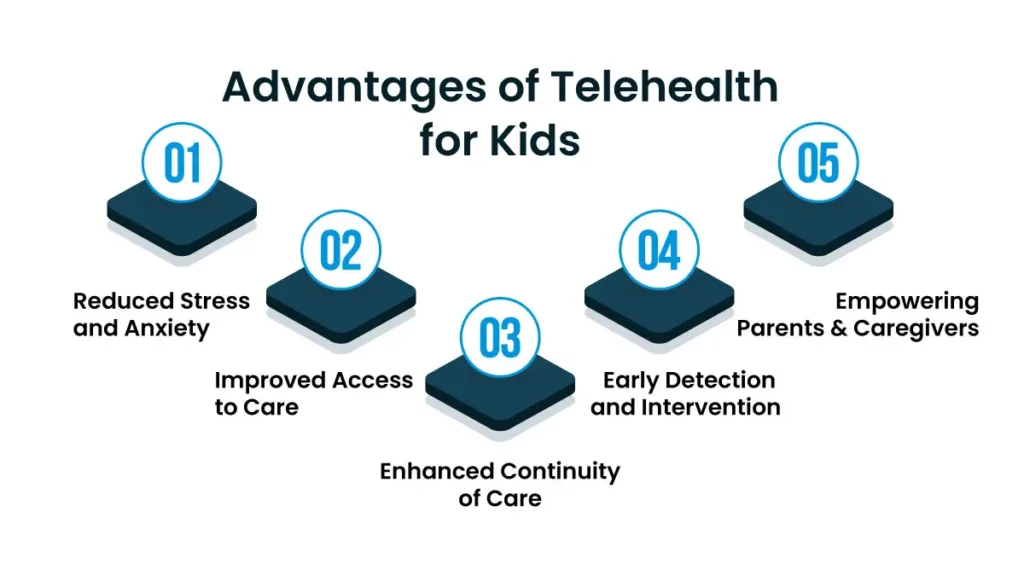

As parents and caregivers, ensuring your children receive the best possible care is a top priority. However, navigating traditional healthcare appointments amidst our busy lives can be challenging. From scheduling conflicts to long wait times, ensuring timely access to necessary care can feel overwhelming.
Fortunately, the world of pediatrics is undergoing a positive transformation with the emergence of telehealth. This innovative approach utilizes technology to connect families with healthcare professionals remotely, offering a convenient and effective solution for managing our children’s health needs.
This blog delves into the numerous benefits of telehealth for children, showcasing its potential to improve access, enhance convenience, and empower families to participate in their children’s well-being journey actively.
As we venture deeper into the 21st century, the healthcare landscape is undergoing a remarkable transformation, driven by technological advancements that promise to enhance the quality and accessibility of care.
Among these innovations, telehealth pediatrics stands out as a beacon of progress. For pediatricians, embracing telehealth solutions is not just an option; it’s a forward-thinking approach to medicine that aligns with the evolving needs of their patients and the dynamics of modern healthcare. Let’s explore why pediatricians should not just consider but actively embrace telehealth solutions.
First and foremost, telehealth demolishes the traditional barriers that have long made accessing pediatric care a challenge for many families. Geography, transportation issues, and the constraints of a 9-to-5 clinic schedule are no longer insurmountable obstacles.
Telehealth enables pediatricians to reach their patients wherever they are, ensuring that children in rural or underserved areas receive the same level of care as those in urban centers.
Pediatric virtual care can help pediatricians spend quality time with their patients, understanding their concerns in a comfortable and familiar environment. This level of engagement fosters a stronger doctor-patient relationship, leading to higher satisfaction rates among patients and their families.
Moreover, the convenience of telehealth reduces no-show rates and makes healthcare a less stressful affair for parents and caregivers.
The flexibility of telehealth services allows pediatricians to offer more timely and efficient care. Routine follow-ups, medication management, and patient education can be conducted virtually, freeing up valuable clinic time for more complex cases that require in-person attention.
This not only optimizes the pediatrician’s workflow but also ensures that patients receive care promptly, potentially preventing minor issues from escalating into serious health problems.
As a parent, you may want your child can receive quality medical care from the comfort and familiarity of your own home. Telehealth offers a multitude of advantages specifically tailored to benefit your child’s health and well-being:

Reduced Stress and Anxiety: Telehealth allows children to connect with healthcare professionals in a familiar and calming environment, leading to a more relaxed and positive experience.
Improved Access to Care: Telehealth bridges the gap, making timely medical attention more readily available, especially for families in remote areas or with busy schedules.
Enhanced Continuity of Care: Regular check-ins and follow-up consultations with your child’s healthcare provider become a breeze with telehealth. This streamlined communication fosters a stronger patient-doctor relationship and allows for proactive management of your child’s health.
Early Detection and Intervention: Telehealth consultations can be particularly beneficial for monitoring chronic conditions or identifying potential health concerns early on. This allows for timely intervention and management, leading to better long-term outcomes for your child.
Empowering Parents and Caregivers: Telehealth equips you with the tools and knowledge to become more actively involved in your child’s healthcare journey. You can easily access educational resources, ask questions, and receive guidance from healthcare professionals in the comfort of your own home.
While telehealth is fantastic for regular check-ups, its true strength lies in its ability to address diverse situations and conditions.
Behavioral Health: Telehealth provides a safe and comfortable space for children to connect with mental health professionals, allowing them to receive counseling, therapy, and support from the comfort of their own homes.
Chronic Conditions: Telehealth empowers children with chronic illnesses, such as asthma, diabetes, and allergies, to receive consistent monitoring, medication management, and support from their healthcare teams remotely, reducing the burden of frequent in-person visits.
Acute Needs: From minor illnesses like colds and earaches to sudden injuries, telehealth consultations can provide timely and convenient solutions, allowing for diagnosis, treatment recommendations, and prescriptions without the need for an immediate office visit.
Special Healthcare Needs: Children with complex medical conditions often require ongoing care and monitoring. Telehealth bridges the gap, facilitating regular consultations, specialist interactions, and medication adjustments remotely, reducing stress and improving accessibility for these vulnerable families.
In conclusion, the integration of telehealth into pediatric care represents a significant leap forward in ensuring that our children receive the best possible healthcare, regardless of their location or our busy schedules. By embracing this technology, we not only break down traditional barriers to access but also enhance the quality of care through improved patient engagement, streamlined services, and early intervention capabilities.
Whether it’s managing chronic conditions, addressing acute needs, or supporting behavioral health, telehealth offers a versatile and empowering approach to pediatric healthcare. As we move forward, it’s clear that telehealth will continue to play a pivotal role in shaping the future of pediatric care, making it more accessible, efficient, and patient-centered than ever before.
Talk to an Expert Now